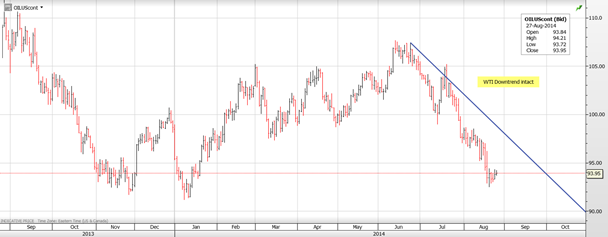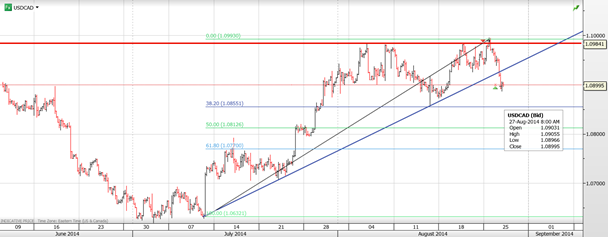- USD/CAD bulls squeezed on merger news
- Dovish Bank of Canada governor and soft WTI oil may limit Canadian dollar gains
- USD/CAD technicals argue for test of recent lows
News of the tax-driven takeover of the iconic Canadian doughnut chain Tim Hortons (NYSE:THI) by Burger King (NYSE:BKW) put USD/CAD in a very active overnight session. Canadian dollar buyers crawled out of the woodwork on anticipation of CAD12 billion being purchased to fund the takeover, even though there are still a few hurdles to jump.
Canadian regulatory approval should be a done deal considering that this isplunge the second time that Tim Hortons has been purchased by a US company (after its merger with Wendy's in 1995). The US government will likely give its blessing, though begrudgingly so, owing to the tax-inversion nature of the transaction. The 39% share price premium should ensure shareholder approval as well.
Devil's in the details
The sheer size of the possible Canadian dollar demand will overhang USD/CAD trading until the deal closes, which hasn't been announced yet. The other issue is that shareholders have the option of taking all stock. If 50% of shareholders elect this option, the volume of Canadian dollars needed to close the transaction drops to about CAD4.35 bn, still chunky, but far less disruptive. The reality is that even though the headline touts a US$12 bn deal, the actual Canadian dollar demand will be substantially less.
Putting lipstick on a Loon
The potential Canadian dollar demand from the deal has altered the short-term outlook for the Loonie and renewed the focus on the 1.0800-10 area, which for many is akin to putting lipstick on a pig.
USD/CAD bulls are taking solace from Bank of Canada Governor Stephen Poloz's comments at the weekend. In an interview with The Globe And Mail, Poloz said: “The main thing people should understand is that our policy is quite capable of being fully independent, as it has been these past few years.” The remarks imply a lag between any US rate hike and a similar move in Canada. This dovish view is expected to be reiterated and reinforced next week (September 3) in the interest rate statement following the rate announcement.
There hasn't been much in the way of USD/CAD/WTI correlation this year, but if WTI continues to decline the Canadian dollar will follow suit. 
Source: Saxo Bank
Month-end portfolio rebalancing a plus for USD/CAD bears
Strong US equity market gains in August are suggesting a need to sell USD/CAD to rebalance portfolio's at month-end. USD/CAD bears are feeling pretty good. The failure to extend gains above 1.1000 this week combined with the drop below 1.0920 removes the short-term upside pressure. The steady diet of improving Canadian economic data diminishes the concerns that domestic economic growth will lag that of the US. The negative outlook for EUR/USD on interest rate divergence has led to renewed selling of EUR/CAD. The break in key support levels in this currency pair points to further losses ahead and is CAD supportive. GBP/CAD selling and CAD/JPY buying are also contributing to the bearish USD/CAD bias.
USD/CAD technical outlook
The short-term USD/CAD technicals are bearish following the break of the July uptrend line at 1.0925 that was intact since July 7 and is aiming for support in the 1.0860-80 area. The support is derived from the 100-day moving average (1.0861) and the 200-day moving average (1.0881). In addition, the rejection of additional gains above 1.1000 reinforces the strength of that resistance area that should attract sellers on any future USD/CAD rallies. The 38.2% Fibonacci retracement of the July 1.0630 to August 1.0994 range comes into play at 1.0855 with the 61.8% retracement at 1.0770. The strong resistance in the 1.0980-1.1000 area should cap any top-side forays, while the 100- and 200-day moving averages should limit the downside. The range for the next week is likely 1.0860-1.0980 with a risk toward 1.0810.
Source: Saxo Bank
-- Edited by Oliver Morrison
Michael O'Neill is an FX consultant at IFXA Ltd
